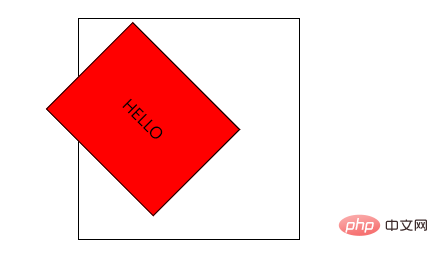
In CSS3, you can use the "transform-origin" attribute to set the rotation center point of rotate. This attribute can change the position of the transformed element. The first parameter sets the rotation position of the x-axis, and the second parameter sets Y-axis rotation position, the syntax is "transform-origin:x-axis position y-axis position".

The operating environment of this tutorial: Windows 10 system, CSS3&&HTML5 version, Dell G3 computer.
The rotate() function is a built-in function used to rotate elements based on a given angle as a parameter. Angle can be set in degrees, ticks, radians or turns.
Usage:
rotate( angle )
Parameters: This function accepts a single parameter angle representing the rotation angle. Positive and negative angles rotate the element clockwise and counterclockwise respectively.
The following example illustrates the rotate() function in CSS:
Example 1:
<!DOCTYPE html>
<html>
<head>
<title>CSS rotate() function</title>
<style>
body {
text-align:center;
}
h1 {
color:green;
}
.rotate_image {
transform:rotate(45deg);
}
</style>
</head>
<body>
<h1>GeeksforGeeks</h1>
<h2>CSS rotate() function</h2>
<br><br>
<img class="rotate_image lazy" src="/static/imghw/default1.png" data-src="https://img.php.cn/upload/image/189/234/232/1650768555372311.jpg" src=
"https://media.geeksforgeeks.org/wp-content/cdn-uploads/20190710102234/download3.png"
alt="GeeksforGeeks logo">
</body>
</html>Output:

The transform-Origin attribute allows you to change the position of the transformed element.
2D transform elements can change the X and Y axes of the element. Transform elements in 3D and also change the Z-axis of the element.
The syntax is:
transform-origin: x-axis y-axis z-axis;
x-axis defines where the view is placed on the X-axis.
y-axis defines where the view is placed on the Y-axis.
The example is as follows:
<!DOCTYPE html>
<html>
<head>
<meta charset="utf-8">
<title>123</title>
<style>
#div1
{
position: relative;
height: 200px;
width: 200px;
margin: 100px;
padding:10px;
border: 1px solid black;
}
#div2
{
padding:50px;
position: absolute;
border: 1px solid black;
background-color: red;
transform: rotate(45deg);
transform-origin:20% 40%;
-ms-transform: rotate(45deg); /* IE 9 */
-ms-transform-origin:20% 40%; /* IE 9 */
-webkit-transform: rotate(45deg); /* Safari and Chrome */
-webkit-transform-origin:20% 40%; /* Safari and Chrome */
}
</style>
</head>
<body>
<div id="div1">
<div id="div2">HELLO</div>
</div>
</body>
</html>Output result:

(Learning video sharing: css video tutorial)
The above is the detailed content of How to set rotate at the rotation center point in css3. For more information, please follow other related articles on the PHP Chinese website!